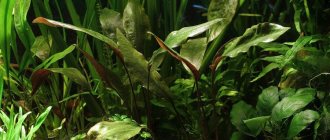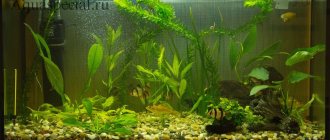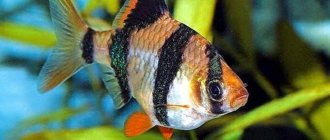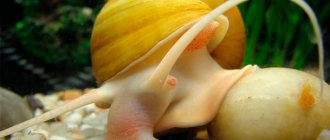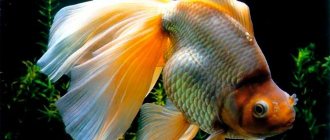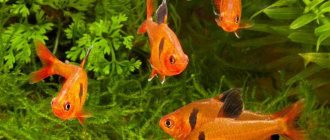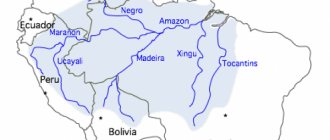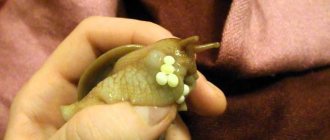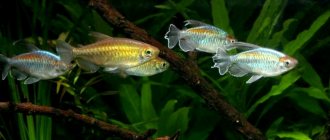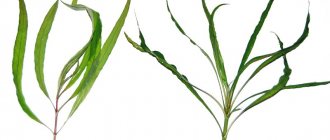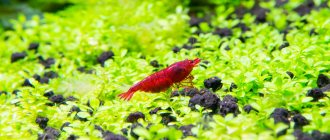Habitat
Under natural conditions, lemongrass is found in water bodies of Southeast Asia. This species loves shallow waters, but can also grow along the coast of larger lakes and ponds. This is a semi-aquatic crop that thrives in both water and air.
Nomaphyla leaves are arranged crosswise and give the impression of a regular geometric pattern.
In aquariums, nomaphila grows year-round, actively and quickly. High aesthetic values make this representative of the aquatic flora a favorite among other aquarium crops. Especially considering the ease and simplicity of care.
Brief description and appearance
The algae Schisandra, or Indian great swampweed, is officially called in Latin as Nomaphila stricta.
The plant is a member of the Acanthus family and exudes a subtle citrus aroma. The described plant produces a long and fairly strong straight stem. It is bordered by oval leaves with slightly pointed edges, painted in light green shades and having pronounced veins. The leaves are attached to the base in pairs, grow up to 10-12 cm in length, and reach an average width of 3-5 cm. During the flowering period, small bluish inflorescences appear.
The freshwater plant is called the even greater Indian swampweed. At the moment, no more than 10 species are known, but this is inaccurate data, since botanists have not yet come to a consensus on the classification of genera.
The appearance of the algae is spectacular. The straight, strong stem is crowned with oval-shaped leaves with pointed ends. The outer part of the leaf is light green, the underside is silver. The average length of the leaves is 12 cm, width - 3. Veins are clearly visible on the front surface, attached to the stem in pairs.
Schisandra does not exceed 30 cm, blooms with small blue flowers. Due to active growth, it sometimes rises above the water, in which case the leaves become slightly rough. Decorative qualities remain unchanged. The ability to live in two environments at once allows Nomaphiles to be used in tanks with a semi-aqueous component. Turtles and other species of amphibians live in these.
The benefits of lemongrass for the aquarium
When discussing the merits of any aquatic plant, it is customary to consider culture from two positions: aesthetics and pragmatics. In terms of aesthetics, nomaphila enjoys well-deserved respect among aquarists. As for pragmatism, the advantages are the following features of this plant:
- Schisandra is a natural biofilter. Aquatic culture effectively cleanses the water area from waste products of living organisms.
- This culture actively absorbs CO2 (carbon dioxide), enriching the aquatic environment with the necessary oxygen.
- Luxurious dense vegetation provides good shelter for many aquarium inhabitants.
It is recommended to plant lemongrass in jars containing fish that require protection and prefer privacy.
Planting and propagation
There are several types of cultivation of Schisandra:
- When dividing by cuttings, cut off the top of an adult plant. As a result, many side shoots appear, which are carefully separated and planted in the ground.
- Growing in a high-humidity greenhouse begins by placing the plant in a container with a small amount of liquid. After some time, aerial roots appear and the plant is ready to be planted in the ground. Garden soil with the addition of sand and clay is best suited.
- Nomaphiles grow much faster in air. Sprouts from a greenhouse take root much better in an aquatic environment. On average, the plant adds up to 10 cm in height every week. In order to control the development of algae, it is planted in the ground in a small plastic pot. Lack of space for the development of the root system leads to slower growth.
Features of cultivation
If the nomafile is provided with good and favorable conditions, it begins to grow at such a speed that in a short time it can fill almost the entire aquarium.
To prevent the “invasion of green mass”, it is better to plant the crop in pots. Small clay containers will prevent the root system of the crop from actively developing and slow down the growth rate.
When choosing a suitable clay pot for lemongrass, do not choose containers that are too large.
In massive pots, lemongrass inhibits the growth of leaf mass - it devotes all its strength to the formation of roots. Nomafile requires regular pruning as it grows. A neat haircut helps to build up lateral shoots, which gives the bush fullness.
- Schisandra, with its thick foliage, requires a large aquarium - with a volume of 140-150 liters. If the dimensions of the jar are smaller, then you can plant only one plant (usually nomaphyla is planted in a group).
- The ideal place for it is the background of the container. Then the plant will provide a beautiful green background and will not “take away” the free space, providing the fish with access for free swimming.
Required water parameters
Schisandra is a plant that came to us from the tropics. Therefore, the culture requires increased water temperature. This rule should not be neglected, because a decrease in temperature even by 2-3⁰С from the permitted level greatly inhibits the growth and development of nomaphila.
When the temperature of the aquatic environment drops to +20⁰С, lemongrass dies.
The requirements for water parameters are no less stringent. The plant will grow well in an aquatic environment that differs:
- hardness (from 8⁰);
- acidity (from 7 pH);
- the presence of nitrates (from 10 mg/1 l of water).
It is necessary to adjust water parameters carefully - this aquatic culture is sensitive. And under inappropriate conditions, nomaphila leaves will quickly fall off, and instead of a plant rich in foliage, you will get a long bare stem.
Lighting conditions
Schisandra needs bright light in large quantities. After all, in nature the plant grows under constant hot tropical sun. Therefore, the aquarium must be equipped with auxiliary lighting sources.
The backlight power is calculated from the volume of the container. For every 1-1.5 liters, half a watt of power is needed.
- You can use any lamps: fluorescent, incandescent or LED spotlights. Try to ensure that the water area is fully illuminated, in every corner.
- Be sure to also provide side lighting - it will help protect the lower leaves of the lemongrass. Daylight hours for nomafil are set at 12-13 hours. If there is enough light, the crop will react to this with a dark brown color of the stem.
Optional equipment
Since we are equipping a tropical aquarium for Schisandra, a good filtration system becomes necessary. But powerful aeration is not required in the aquarium where Nomafila grows. This culture is capable of independently solving the problem of purification.
To prevent the water stream from interfering with the plant and harming it, use special devices for dispersing the stream - a “flute” or a “waterfall”.
What kind of soil is needed?
When planting lemongrass, it is advisable to place a layer of clay under its root system.
The clay layer will allow the roots to take root well and quickly take root in the crop. In this case, additional feeding is not needed. If there is no clay substrate, you need to add tablets for feeding aquatic crops - for example, Tetra-Crypto - under the roots of lemongrass. The total thickness of the soil should be between 6-7 cm.
Necessary fertilizers
Nomafila needs regular feeding. Without an additive containing magnesium, calcium and phosphorus, the crop will lose its rich appearance, and its leaves will begin to curl, wither, turn yellow and become covered with brownish spots. Therefore, as soon as such signs are noticed, complex fertilizer is added to the aquatic environment.
It is necessary to constantly feed Schisandra in small quantities so that the plant gets used to the food. A sudden and sharp increase in microelements in water can negatively affect the condition of the crop.
Ground and lighting
It is advisable to silt the soil in an aquarium with lemongrass and enrich it with nutrients. It doesn’t really matter what kind of substrate is in your aquarium, since the plant has a strong, well-developed root system. The main thing is to spread it in a layer of at least 5 cm, since if the layer is insufficient, the rhizome will have nowhere to grow, and the stem and leaves will develop very, very weakly.
Periodically thin out the thickets of the plant so that there is no excessive thickening, otherwise they can densely shade the bottom areas. When transplanting nomaphila, place a piece of clay under its root.
It is also necessary to provide good lighting using fluorescent lamps with a power of 0.5 W per liter of water. If there is not enough light, the lower leaves of the lemongrass will begin to die, so it would be a good idea to use incandescent lamps for additional illumination. To preserve old leaves, install this type of lighting on the side of the aquarium. The ideal option is to create a daylight period of at least 12 hours, then the plant will develop fully.
How to propagate lemongrass
Nomaphyla propagates by cuttings. It's very easy to do this:
- The upper shoots are carefully trimmed from a healthy plant.
- The cuttings are placed in separate containers (it is better to use clay pots) and placed in the soil of the aquarium.
- As soon as the shoots take root, the crop is transferred to permanent residence.
You can let the cut cuttings go into the water area for “free swimming”. But in this case, the upper leaves of the crop will actively reach towards the light. Because of this, the spine takes on an irregular, curved shape (this defect cannot be corrected).
Pruning the top shoots of Schisandra does not harm the crop. On the contrary, such a procedure leads to an increase in the lushness and density of foliage.
Why is Schisandra called hygrophila and nomaphila?
Usually, when it comes to the classification of Schisandra, the primacy in the description is given to Karl Ludwig von Blum.
This is the same scientist who, while studying the flora of South Asia in 1826, described the plant as Nomaphila corimbosa. A little later, in 1895, another botanist (Gustav Lindau) again described the plant. And he gave it the systematic name Hygrophila corimbosa. However, Lindau took advantage of earlier works than Blum. The fact is that the genus Hygrophila was originally described in 1810 by Robert Brown. Since the plant was found to belong to the genus Hygrophila, Schisandra received the official name Hygrophila corimbosa. By the way.
For some time, lemongrass was classified in the genus Justicia. Much earlier, before the plant was named hygrophila and nomaphyla, Martin Wahl, a student of the famous Carl Linnaeus, had the opportunity to meet this herb in nature and give it a name, assigning it to the genus Justicia.
It is a little unclear what guided the botanist in his work. But time put everything in its place and the plant took its present position. However, confusion in names often confuses aquarists.
Thus, there is no reason to start a debate about the correct name of the aquarium plant.
In addition to the “main” names, lemongrass has a number of synonyms. These are Nomaphila angustifolia, salicifolia, siamensis and stricta.
Varieties of lemongrass
The genus Nomaphila was described by the botanist-naturalist Blumen in 1861. All representatives of this family come from the subtropics and tropics of Asia and Africa.
The total number of varieties of this crop fits into 10 species. Experts include the following among the most common aquarium plants of the Nomafil genus:
| Name | Description | Peculiarities |
| Longifolia | visually similar to narrow-leaved hygrophila, this species can also grow on the surface of the water, but in the air the leaves of nomaphila shorten, become coarser, and the stem becomes pubescent | is not as strict with regard to lighting as lemongrass and retains foliage longer in slightly hard water; cuttings of the crop quickly take root and get used to the new environment |
| Serrated | has wide leaf blades with pronounced denticles | not as decorative as other subspecies, does not tolerate soft water well |
| Thai | a large plant with a very dense foliage, the leaf blade can reach up to 10-12 cm in length and 2-3 cm in width | has high decorative qualities, prefers water of medium hardness |
Aquarium plant Schisandra: diseases, treatment methods
Changes in the conditions and standards for maintaining nomaphila can cause various diseases.
Eliminating unfavorable factors will return the lemongrass aquarium plant to its healthy appearance. The development of aquarium lemongrass occurs continuously; for it there is no autumn-winter period of slowing down life processes. If the specified parameters of water and light are observed, and there is a sufficient amount of nutritious soil, the plant will delight you with lush foliage, a pleasant lemon aroma and delicate flowers all year round.
Loading…
Compatibility with aquarium inhabitants
Among the huge assortment of fish, shrimp, aquarium crayfish and crabs, lemongrass has only one “enemy”.
This is a sticky or cleaner catfish (Ancitrus). The catfish loves to feast on nomaphila leaves, which causes great damage to the decorative qualities of the plant.
Schisandra has no enemies among the plant representatives of the aquatic area. But it is worth taking into account the active growth of this plant, which can literally occupy the aquarium space and certain requirements for water parameters.
Not every aquatic culture adheres to exactly these criteria.
Do not plant crops of other species too close to lemongrass. Better yet, separate them with decorative accessories (driftwood, stone, etc.).
- Any type of aquatic plants that feel comfortable in the conditions required by lemongrass can be planted in a container with lemongrass.
- And species like Pistia (whose leaves drift along the water surface) must be treated carefully, preventing them from growing.
- Otherwise, lemongrass will not have access to the surface of the water - and for this species it is very important to grow not only in the water layers, but also above them.
Difficulty in content
If favorable conditions are created for lemongrass, then it begins to grow extremely quickly, increasing the green mass with such force that it can quickly occupy the entire territory of the aquarium (aquarists often complain about this on Internet forums). To take control of the process, experts recommend planting plants not in the ground, but in a small clay pot. It will not allow the root system to develop too rapidly, and this will somewhat slow down the activity of the green part of the plants.
ATTENTION: a pot for lemongrass that is too large can cause the plant to slow down in growth for a long period of time - its main activity will be focused on growing the root system, and not the green part. By the way, plants really need periodic “haircuts.”
Thanks to it, side shoots grow, which adds lushness and beauty to the lemongrass.
By the way, periodic “haircuts” are very necessary for plants. Thanks to it, side shoots grow, which adds lushness and beauty to the lemongrass.
Compatibility with other aquarium inhabitants
Among the active inhabitants of the aquarium, Schisandra has one enemy - the Ancistrus fish (it is also called the sticky catfish, the cleaner catfish). This fish is not averse to eating the delicate foliage of the plant, which spoils its appearance.
But among plants, lemongrass has almost no enemies. Unless he, a tropical representative, would have to adapt to the Spartan living conditions that are pleasant to some other plant. But a caring owner usually selects representatives of flora and fauna with the same set of requirements, so that no one is disadvantaged.
The problem may be one thing: an overly active lemongrass will take over the entire living space of the “glass house”, not giving other plants the opportunity to fully develop. The solution is to control the growth of the “invader” by performing regular pruning. In addition, experts do not recommend planting plants very close to each other; moreover, it is necessary to separate each green pet with a stone or snag.
ATTENTION: if there is a Pistia in the aquarium (its rosette leaves drift along the surface of the water), you need to make sure that it does not grow, otherwise the lemongrass will not be able to escape, and this is important for it
Diseases, their treatment and prevention
Schisandra gets sick if the comfortable environment to which it has adapted is disrupted. Changed coloration and stunted growth indicate that problems have arisen. What are the causes and consequences of the disease:
- low temperature - the stem does not grow, the leaves are fragile and small;
- soft water - plants are destroyed;
- a thin layer of soil insufficient for roots - the plant develops poorly;
- little light - leaves die, starting from the lower ones;
- lack of nutrients in the water - leaves change color.
ATTENTION: if Schisandra is sick, it will not bloom, and you will not have a chance to watch this wonderful phenomenon
Lifespan
The lifespan of aquarium lemongrass is difficult to limit to any period of time. “In the hands” of a caring owner who provides his green pet with proper care, we can talk about a continuous cycle, a kind of continuity, when plants replace each other without losing their freshness and decorativeness. An important point: for lemongrass there is no change of seasons, periods of “oppression” or “hibernation” - it grows the same way all year round. In addition, it is very active - sometimes it gives a weekly increase of up to ten centimeters.
Average price and where to buy
You can buy lemongrass online on almost all sites that offer aquarium plants for sale: lemongrass is not a rare representative of underwater flora. You can buy it in the form of a separate branch (100 - 150 rubles per branch 10 centimeters long) or in a pot (plant length - up to 15 centimeters), then it can cost up to 720 rubles. Examples of sites that carry out sales are www.aqua-tver.ru, dennerle-plant.ru.
What problems might you encounter?
For lemongrass, it is extremely important to comply with all the requirements established for it regarding the composition of water and illumination. If the rules are not followed, the plant begins to wither and get sick. All shortcomings will be evidenced by a change in culture:
- poor stem growth, shredding of leaves, their fragility: decreased temperature of the water layer;
- falling leaves, exposure of the plant stem: too soft water environment;
- poor crop growth: excessively thin soil layer;
- death of deciduous mass: lack of light;
- change in the color of the leaves, the appearance of spots on them: lack of nutrients.
Schisandra can also bloom with small flowers of unusual beauty. If the plant feels uncomfortable, gets sick and weakens, it will not bloom.
The lifespan of an aquatic plant also depends on attention and proper care. In skillful hands, lemongrass grows continuously, shoots change each other, providing the culture with an almost endless life. Under comfortable conditions, lemongrass can increase its growth by up to 10-12 cm per week.
Diseases
External defects, changes in leaf color and size are the consequences of improper care. Timely measures to eliminate the causes of diseases will return Schisandra to its original appearance.
| Sign | Cause | Treatment |
| Small fragile leaves, growth has stopped. | Cold water. | Change water, approximately 40% of the total volume. Heat to 28°C. |
| Change in color of leaves and stems to a lighter color followed by death. | Incorrect lighting. | Extend daylight hours to 12 hours a day. Install additional side light sources. |
| Leaves and stems rot. | Violation of the chemical composition of the water (too soft). | Marble chips and rapan shells increase water hardness. Calcium carbonate is also added at the rate of 2 tsp. for 50 l. |
| Stunted plant, go to bed. | Insufficiently dense soil layer. | Increase layer thickness. |
| Yellowing and defects of leaves. | Lack of nutrition. | It is necessary to carry out complex feeding. |
A timely integrated approach will help maintain Schisandra in ideal condition throughout the year. But even with good care, the plant needs to be updated regularly.
With proper care, nomaphila blooms and pleases the eye, and there are no spots or growths on the leaves and stems. If conditions are violated, the plant becomes ill, as evidenced by the following signs:
- loss of integrity of leaves and small spots on them - the reason lies in too soft water;
- large dark spots – low water temperature; poor development and fragility - small thickness of the substrate;
- light or pale yellow spots – magnesium deficiency;
- leaves turn yellow and change shape, curling - lack of potassium;
- dying leaves - lack of lighting or too soft water;
- discoloration and purple spots on the leaves are a lack of nutrients.
To prevent the plant from getting sick, aquarists additionally feed the flower by adding mineral fertilizers to the water. Without these nutrients, lemongrass loses its beauty and develops poorly. The main signs that nomaphile does not have enough attention and care are spots on the stem and leaves, as well as the absence of blue flowers.
Many aquarists are attracted by the simple conditions of keeping lemongrass - aquarium plants are not capricious, but are still prone to disease if their usual habitat is disturbed. They change their color and also stop growing.
Causes and consequences of the disease:
- when there is insufficient lighting, leaves begin to die;
- soft water destroys plants;
- the changed color of the leaves is a consequence of a lack of nutrients in the soil; they can become yellowish, with brown or reddish spots and even curl;
- stunted growth, small and fragile leaves - means low water temperature;
- lack of flowering also indicates the presence of diseases;
- poor development of the plant indicates that its roots do not have enough soil.
